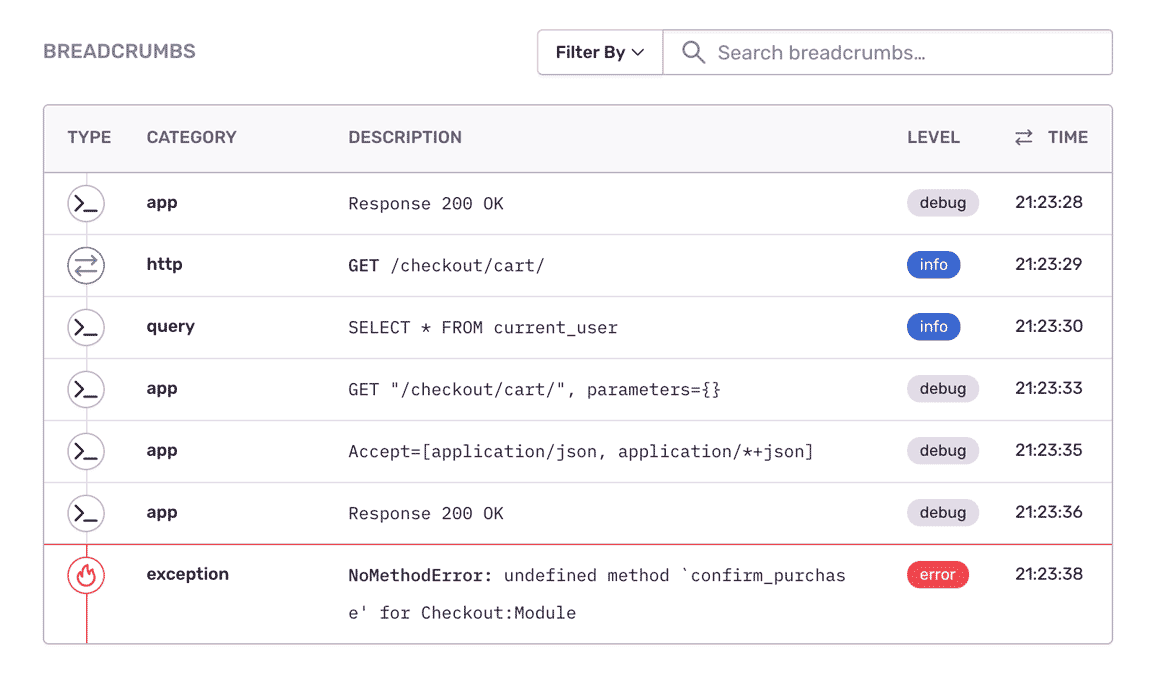
Rails Error and Performance Monitoring
Rails Actionable insights to resolve Rails performance bottlenecks and errors. Improve your Rails monitoring workflow with a full view of releases so you can mark errors as resolved and prioritize live issues.
Getting Started is Simple
Add sentry-ruby and sentry-rails to your Gemfile:
gem "sentry-ruby" gem "sentry-rails"
Initialize the SDK within your config/initializers/sentry.rb:
Sentry.init do |config| config.dsn = 'https://<key>@sentry.io/<project>' config.breadcrumbs_logger = [:active_support_logger] # To activate Tracing, set one of these options. # We recommend adjusting the value in production: config.traces_sample_rate = 1.0 # or config.traces_sampler = lambda do |context| true end end
Check our documentation for the latest instructions.
See all platforms
Rails Performance Monitoring
Quickly identify Rails performance issues and view full end-to-end distributed trace to see the exact, poor-performing API call and surface any related errors.

Rails Monitoring with Complete Stack Traces
Take advantage of built-in integrations with Rails, Sidekiq, DelayedJob, and more of your favorite RubyGems. Enable asynchronous reporting so errors are logged quickly in a background job. Filter and group Rails exceptions intuitively to eliminate noise.

Fill In The Blanks About Rails Errors
Expose important events that led to each Rails exception: a string to label where the event took place, message, timestamp. Learn in which version a bug first appeared, merge duplicates, and know if things regress in a future release.
“Sentry has become mission-critical to the way we build and ship software.”
See the Full Picture of Any Rails Exception
Get the user’s unique id, contact info, and IP address, as well as any localization as context to resolve the error and notify your customer.
Index and aggregate tags to easily search your error reports, see the distribution of issues, and find what’s a priority or a trend.
Find answers to key questions: Is the Rails exception limited to a single server? What arguments caused the ActiveJob to fail?
It’s why companies that don’t have a complete view of their infrastructure are being punished:
The average cost of network downtime is around $5,600 per minute — or $300,000 per hour.
1 out of 5 online shoppers will abandon their cart because the transaction process was too slow.
On average, a two-second slowdown in page load decreases revenues by 4.3 percent.
FAQs
Sentry supports every major language, framework, and library. You can browse each of them here.
You can get started for free. Pricing depends on the number of monthly events, transactions, and attachments that you send Sentry. For more details, visit our pricing page.
Sentry doesn’t impact a web site’s performance.
If you look at the configuration options for when you initialize Sentry in your code, you’ll see there’s nothing regarding minimizing its impact on your app’s performance. This is because our team of SDK engineers already developed Sentry with this in mind.
Sentry is a listener/handler for errors that asynchronously sends out the error/event to Sentry.io. This is non-blocking. The error/event only goes out if this is an error.
Global handlers have almost no impact as well, as they are native APIs provided by the browsers.
Supporting Resources
A better experience for your users. An easier life for your developers.
A peek at your privacy
Here’s a quick look at how Sentry handles your personal information (PII).
×Who we collect PII from
We collect PII about people browsing our website, users of the Sentry service, prospective customers, and people who otherwise interact with us.
What if my PII is included in data sent to Sentry by a Sentry customer (e.g., someone using Sentry to monitor their app)? In this case you have to contact the Sentry customer (e.g., the maker of the app). We do not control the data that is sent to us through the Sentry service for the purposes of application monitoring.
Am I included?PII we may collect about you
- PII provided by you and related to your
- Account, profile, and login
- Requests and inquiries
- Purchases
- PII collected from your device and usage
- PII collected from third parties (e.g., social media)
How we use your PII
- To operate our site and service
- To protect and improve our site and service
- To provide customer care and support
- To communicate with you
- For other purposes (that we inform you of at collection)
Third parties who receive your PII
We may disclose your PII to the following type of recipients:
- Subsidiaries and other affiliates
- Service providers
- Partners (go-to-market, analytics)
- Third-party platforms (when you connect them to our service)
- Governmental authorities (where necessary)
- An actual or potential buyer
We use cookies (but not for advertising)
- We do not use advertising or targeting cookies
- We use necessary cookies to run and improve our site and service
- You can disable cookies but this can impact your use or access to certain parts of our site and service
Know your rights
You may have the following rights related to your PII:
- Access, correct, and update
- Object to or restrict processing
- Port over
- Opt-out of marketing
- Be forgotten by Sentry
- Withdraw your consent
- Complain about us
If you have any questions or concerns about your privacy at Sentry, please email us at compliance@sentry.io.
If you are a California resident, see our Supplemental notice.